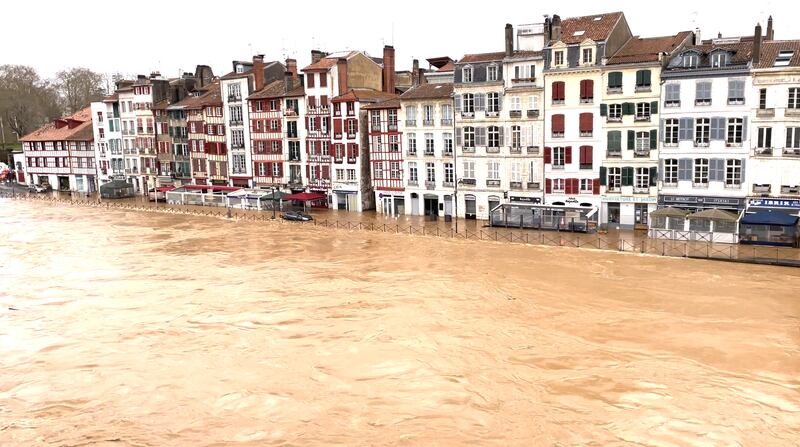Genoese ships travelling from Crimea brought the Black Death to Messina in Sicily in October 1347. First carried by rats, the disease then spread through the air between victims. They developed swellings in the groin, neck and armpits that oozed pus, then black spots on the skin. They died within two to seven days.
Bodies went unburied as the undertakers and priests had also succumbed or fled. Florence prevented ill travellers and animals from entering, cleaned the city streets and made the inhabitants stay at home. Nevertheless, as much as 80 per cent of the citizens perished.
As the plague raged through the Middle East and Europe, returning three more times in the 14th century, between 30 per cent and 60 per cent of the European population died and the world population shrank by 100 million, or more than a fifth.
This was not the century’s first disaster. Over the preceding four centuries of comfortable temperatures, the “Medieval Warm Period”, the European population had tripled. Marshlands were drained, forests felled and cultivation spread into increasingly marginal land. Some parts of France were more populous then than they are even today.
Between 1302 and 1307, the continent experienced exceptionally hot and dry weather. The Nile dropped to unusually low levels, and after a two-year drought, 1,700 homes in Florence were destroyed in a fire.
Then came a spell of unusual cold and rain from 1310. Between 1315 and 1317, after repeated harvest failures, a great famine struck Europe as far east as Russia, killing 10 per cent to 15 per cent of the population of towns.
The “Dantean Anomaly” may have inspired the great Florentine poet in his descriptions of Hell, and the enormous flood in Frankfurt of July 1342 is still commemorated. The western Norse settlement in Greenland was abandoned around 1350 and the eastern settlement disappeared sometime after 1408 as the climate became increasingly chilly.
Europe had entered the Little Ice Age, which would persist until about 1850. And a population weakened by famine was easy prey for the Black Death, perhaps explaining its terrible virulence.
Climatic instability was not just a European phenomenon: Japan, Korea and the Indian city of Rajasthan experienced droughts and famines in the 1360s. The bad weather around the time of the Great Famine might have been triggered by a volcanic eruption throwing ash and sulphates into the stratosphere, possibly that of Mount Tarawera in New Zealand. But the Medieval Warm Period and Little Ice Age were primarily North Atlantic phenomena, not corresponding to unusual global heat or cold.
These disasters put enormous stress on European society. The English ravaged France repeatedly from the outbreak of the Hundred Years’ War in 1337, but after England finally lost the war in 1453, it was then ripped apart by civil conflict, the War of the Roses.
The Jacquerie in 1358 and the Peasants’ Revolt in 1381 involved desperate commoners taking up arms in France and England against the nobility. As tax revenues dwindled, the currency was devalued, feudalism broke down in favour of a money economy and social barriers between classes were weakened.
Repeats of plague and bad weather would be followed by further social and political upheaval, notably in the first half of the 17th century. About 20 per cent of Germany's population died in epidemics and the Thirty Years’ War (1618-1648), and the English Parliament overthrew and executed King Charles I in 1649.
Coming to the present age, 2022 is forecast to be one of the warmest on record. Yet it will be one of the coolest in the rest of the 21st century. It is heating, not freezing, that threatens us now. But the coincidence of climate change and the pandemic shows how fragile political and economic order can be.
When researchers discuss “climate resilience”, they often think of methods such as crop varieties that resist drought, or sea walls to hold off rising waves. Broader economic growth and education assist people in finding their own solutions to local changes in climate.
But we should beware of the indirect and the unpredictable. We are not immune from crop failures even today: rising food prices brought widespread riots and political tensions in 2007 and 2008. Wealthy countries from the US and Europe to Australia have repeatedly failed to cope effectively, honestly and humanely with migration. The prospect of a truly mass migration triggered by climate breakdown or conflict in populous West Africa or South Asia is terrifying.
The dangerous West-Russia tension could be exacerbated by a cold European winter as the Arctic polar vortex surges south. China and the US, already steering into hostility, may blame economic and political turmoil on each other.
This time, the changing climate is not the result of far-off volcanoes or random oscillations of Arctic air, but our own actions. That at least gives us the power to influence it and to alter course. But we should not consider ourselves more rational or able to manage the chaos of human interactions than the unlucky medieval kings and peasants.
Robin Mills is chief executive of Qamar Energy, and author of The Myth of the Oil Crisis






